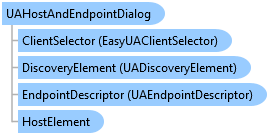

QuickOPC User's Guide and Reference
UAHostAndEndpointDialog Class


'Declaration<CLSCompliantAttribute(True)> <ComDefaultInterfaceAttribute(OpcLabs.EasyOpc.UA.Forms.Browsing.ComTypes._UAHostAndEndpointDialog)> <ComVisibleAttribute(True)> <GuidAttribute("0612DEF8-C143-45F4-A58F-C9C6A2B4AAA6")> <TypeConverterAttribute(System.ComponentModel.ExpandableObjectConverter)> <DesignerCategoryAttribute("Component")> <SerializableAttribute()> Public NotInheritable Class UAHostAndEndpointDialog Inherits UADialog Implements OpcLabs.BaseLib.Forms.ComTypes._FormCommonDialog, OpcLabs.BaseLib.Forms.ComTypes._SizableCommonDialog, OpcLabs.BaseLib.Licensing.ILicensingContextHolder, OpcLabs.EasyOpc.UA.Forms.Browsing.ComTypes._UADialog, OpcLabs.EasyOpc.UA.Forms.Browsing.ComTypes._UAHostAndEndpointDialog, System.ComponentModel.IComponent, System.IDisposable
'UsageDim instance As UAHostAndEndpointDialog
[CLSCompliant(true)] [ComDefaultInterface(OpcLabs.EasyOpc.UA.Forms.Browsing.ComTypes._UAHostAndEndpointDialog)] [ComVisible(true)] [Guid("0612DEF8-C143-45F4-A58F-C9C6A2B4AAA6")] [TypeConverter(System.ComponentModel.ExpandableObjectConverter)] [DesignerCategory("Component")] [Serializable()] public sealed class UAHostAndEndpointDialog : UADialog, OpcLabs.BaseLib.Forms.ComTypes._FormCommonDialog, OpcLabs.BaseLib.Forms.ComTypes._SizableCommonDialog, OpcLabs.BaseLib.Licensing.ILicensingContextHolder, OpcLabs.EasyOpc.UA.Forms.Browsing.ComTypes._UADialog, OpcLabs.EasyOpc.UA.Forms.Browsing.ComTypes._UAHostAndEndpointDialog, System.ComponentModel.IComponent, System.IDisposable
[CLSCompliant(true)] [ComDefaultInterface(OpcLabs.EasyOpc.UA.Forms.Browsing.ComTypes._UAHostAndEndpointDialog)] [ComVisible(true)] [Guid("0612DEF8-C143-45F4-A58F-C9C6A2B4AAA6")] [TypeConverter(System.ComponentModel.ExpandableObjectConverter)] [DesignerCategory("Component")] [Serializable()] public ref class UAHostAndEndpointDialog sealed : public UADialog, OpcLabs.BaseLib.Forms.ComTypes._FormCommonDialog, OpcLabs.BaseLib.Forms.ComTypes._SizableCommonDialog, OpcLabs.BaseLib.Licensing.ILicensingContextHolder, OpcLabs.EasyOpc.UA.Forms.Browsing.ComTypes._UADialog, OpcLabs.EasyOpc.UA.Forms.Browsing.ComTypes._UAHostAndEndpointDialog, System.ComponentModel.IComponent, System.IDisposable
This is a modal dialog box; therefore, when shown, it blocks the rest of the application until the user has made a selection. When a dialog box is displayed modally, no input (keyboard or mouse click) can occur except to objects on the dialog box. The program must hide or close the dialog box (usually in response to some user action) before input to the calling program can occur.
Icon: ![]()
With UAHostAndEndpointDialog, your application can integrate a dialog box from which the user can select a host (computer) and an endpoint of OPC-UA server residing on it. This dialog box combines functions of the Computer Browser Dialog and OPC-UA Endpoint Dialog - ![]() into a single dialog.
into a single dialog.
In addition, the user can add Host nodes in case the particular computer is not visible on the network, or add OPC-UA Endpoint nodes in case the OPC_UA Server is known to exist but is not returned by OPC-UA discovery feature.
Here is an example of OPC-UA Host and Endpoint dialog in action:
If you want to change the parameters of the client object the component uses to perform its OPC operations, you can use the ClientSelector Property.
// This example shows how to let the user browse for a host (computer) and an endpoint of an OPC-UA server residing on it. using System.Windows.Forms; using OpcLabs.EasyOpc.UA.Forms.Browsing; namespace UAFormsDocExamples._UAHostAndEndpointDialog { static class ShowDialog { public static void Main1(IWin32Window owner) { var hostAndEndpointDialog = new UAHostAndEndpointDialog { EndpointDescriptor = {Host = "opcua.demo-this.com"} }; DialogResult dialogResult = hostAndEndpointDialog.ShowDialog(owner); if (dialogResult != DialogResult.OK) return; // Display results MessageBox.Show(owner, $"HostElement: {hostAndEndpointDialog.HostElement}\r\n" + $"DiscoveryElement: {hostAndEndpointDialog.DiscoveryElement}"); } } }
# This example shows how to let the user browse for a host (computer) and # an endpoint of an OPC-UA server residing on it. using namespace OpcLabs.EasyOpc.UA.Forms.Browsing # The path below assumes that the current directory is [ProductDir]/Examples-NET/PowerShell/Windows . Add-Type -Path "../../../Components/Opclabs.QuickOpc/net472/OpcLabs.EasyOpcForms.dll" # Instantiate the dialog object. $hostAndEndpointDialog = New-Object UAHostAndEndpointDialog $hostAndEndpointDialog.EndpointDescriptor.Host = "opcua.demo-this.com" $dialogResult = $hostAndEndpointDialog.ShowDialog() if ($dialogResult -ne [System.Windows.Forms.DialogResult]::OK) { return } # Display results $hostElement = $hostAndEndpointDialog.HostElement if ($hostElement -ne $null) { Write-Host "HostElement: $($hostElement)" } $discoveryElement = $hostAndEndpointDialog.DiscoveryElement if ($discoveryElement -ne $null) { Write-Host "DiscoveryElement: $($discoveryElement)" }
# This example shows how to let the user browse for a host (computer) and an endpoint of an OPC-UA server residing on it. # The QuickOPC package is needed. Install it using "pip install opclabs_quickopc". import opclabs_quickopc # Import .NET namespaces. from System.Windows.Forms import * from OpcLabs.EasyOpc.UA.Forms.Browsing import * hostAndEndpointDialog = UAHostAndEndpointDialog() hostAndEndpointDialog.EndpointDescriptor.Host = 'opcua.demo-this.com' dialogResult = hostAndEndpointDialog.ShowDialog() print(dialogResult) if dialogResult != DialogResult.OK: exit() # Display results. print('HostElement: ', hostAndEndpointDialog.HostElement, sep='') print('DiscoveryElement: ', hostAndEndpointDialog.DiscoveryElement, sep='') print('Finished.')
// This example shows how to let the user browse for a host (computer) and an endpoint of an OPC-UA server residing on it. #include "stdafx.h" // Includes "QuickOpc.h", and other commonly used files #include "ShowDialog.h" namespace _UAHostAndEndpointDialog { void ShowDialog::Main() { // Initialize the COM library CoInitializeEx(NULL, COINIT_MULTITHREADED); { // _UAHostAndEndpointDialogPtr HostAndEndpointDialogPtr(__uuidof(UAHostAndEndpointDialog)); // HostAndEndpointDialogPtr->EndpointDescriptor->Host = L"opcua.demo-this.com"; // DialogResult dialogResult = HostAndEndpointDialogPtr->ShowDialog(NULL); _tprintf(_T("%d\n"), dialogResult); if (dialogResult == 1/*OK*/) { // Display results _HostElementPtr hostElementPtr = HostAndEndpointDialogPtr->HostElement; _tprintf(_T("HostElement: %s\n"), (hostElementPtr == NULL) ? _T("") : (LPCTSTR)CW2CT(hostElementPtr->ToString)); _UADiscoveryElementPtr discoveryElementPtr = HostAndEndpointDialogPtr->DiscoveryElement; _tprintf(_T("DiscoveryElement: %s\n"), (discoveryElementPtr == NULL) ? _T("") : (LPCTSTR)CW2CT(discoveryElementPtr->ToString)); } } // Release all interface pointers BEFORE calling CoUninitialize() CoUninitialize(); } }
// This example shows how to let the user browse for a host (computer) and // an endpoint of an OPC-UA server residing on it. class procedure ShowDialog.Main; var HostAndEndpointDialog: OpcLabs_EasyOpcForms_TLB._UAHostAndEndpointDialog; DialogResult: System_Windows_Forms_TLB.DialogResult; HostElement: OpcLabs_BaseLib_TLB.HostElement; DiscoveryElement: OpcLabs_EasyOpcUA_TLB.UADiscoveryElement; begin // Instantiate the dialog object HostAndEndpointDialog := CoUAHostAndEndpointDialog.Create; HostAndEndpointDialog.EndpointDescriptor.Host := 'opcua.demo-this.com'; DialogResult := HostAndEndpointDialog.ShowDialog(nil); WriteLn(DialogResult); if DialogResult <> DialogResult_OK then Exit; // Display results HostElement := HostAndEndpointDialog.HostElement; if HostElement <> nil then WriteLn('HostElement: ', HostElement.ToString); DiscoveryElement := HostAndEndpointDialog.DiscoveryElement; if DiscoveryElement <> nil then WriteLn('DiscoveryElement: ', DiscoveryElement.ToString); end;
Rem This example shows how to let the user browse for a host (computer) and an endpoint of an OPC-UA server residing on it. Private Sub ShowDialog_Main_Command_Click() OutputText = "" Dim HostAndEndpointDialog As New UAHostAndEndpointDialog HostAndEndpointDialog.endpointDescriptor.Host = "opcua.demo-this.com" Dim DialogResult DialogResult = HostAndEndpointDialog.ShowDialog OutputText = OutputText & DialogResult & vbCrLf If DialogResult <> 1 Then ' OK Exit Sub End If ' Display results Dim HostElement As HostElement Set HostElement = HostAndEndpointDialog.HostElement If Not HostElement Is Nothing Then OutputText = OutputText & "HostElement: " & HostElement & vbCrLf End If Dim DiscoveryElement As UADiscoveryElement Set DiscoveryElement = HostAndEndpointDialog.DiscoveryElement If Not DiscoveryElement Is Nothing Then OutputText = OutputText & "DiscoveryElement: " & DiscoveryElement & vbCrLf End If End Sub
Rem This example shows how to let the user browse for a host (computer) and an endpoint of an OPC-UA server residing on it. Option Explicit Const DialogResult_OK = 1 Dim HostAndEndpointDialog: Set HostAndEndpointDialog = CreateObject("OpcLabs.EasyOpc.UA.Forms.Browsing.UAHostAndEndpointDialog") HostAndEndpointDialog.EndpointDescriptor.Host = "opcua.demo-this.com" Dim dialogResult: dialogResult = HostAndEndpointDialog.ShowDialog WScript.Echo dialogResult If dialogResult <> DialogResult_OK Then WScript.Quit End If ' Display results WScript.Echo "HostElement: " & HostAndEndpointDialog.HostElement WScript.Echo "DiscoveryElement: " & HostAndEndpointDialog.DiscoveryElement
System.Object
System.MarshalByRefObject
System.ComponentModel.Component
System.Windows.Forms.CommonDialog
OpcLabs.BaseLib.Forms.ConcreteCommonDialog
OpcLabs.BaseLib.Forms.FormCommonDialog
OpcLabs.BaseLib.Forms.SizableCommonDialog
OpcLabs.EasyOpc.UA.Forms.Browsing.UADialog
OpcLabs.EasyOpc.UA.Forms.Browsing.UAHostAndEndpointDialog